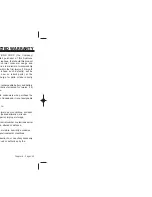
• Design wireless phones in a way that minimizes any RF expo
sure to the user that is not necessary for device function; and
• Cooperate in providing users of wireless phones with the best
possible information on possible effects of wireless phone use
on human health.
FDA belongs to an interagency working group of the federal agen-
cies that have responsibility for different aspects of RF safety to
ensure coordinated efforts at the federal level. The following agen-
cies belong to this working group:
• National Institute for Occupational Safety and Health
• Environmental Protection Agency
• Federal Communications Commission
• Occupational Safety and Health Administration
• National Telecommunications and Information Administration
The National Institutes of Health participates in some interagency
working group activities, as well.
FDA shares regulatory responsibilities for wireless phones with the
Federal Communications Commission (FCC). All phones that are
sold in the United States must comply with FCC safety guidelines
that limit RF exposure. FCC relies on FDA and other health agen-
cies for safety questions about wireless phones.
FCC also regulates the base stations that the wireless phone net-
works rely upon. While these base stations operate at higher
power than do the wireless phones themselves, the RF exposures
that people get from these base stations are typically thousands of
times lower than those they can get from wireless phones. Base
stations are thus not the subject of the safety questions discussed
in this document.
3. What kinds of phones are the subject of this update?
The term “wireless phone” refers here to hand-held wireless
phones with built-in antennas, often called “cell,” “mobile,” or “PCS”
phones. These types of wireless phones can expose the user to
measurable radiofrequency energy (RF) because of the short dis-
tance between the phone and the user’s head. These RF expo-
sures are limited by Federal Communications
Chapter 5 - Page 133
U.S. Food and Drug Administration -
Center for Devices and Radiological Health
Consumer Update on Mobile Phones
1. Do wireless phones pose a health hazard?
The available scientific evidence does not show that any health
problems are associated with using wireless phones. There is no
proof, however, that wireless phones are absolutely safe. Wireless
phones emit low levels of radiofrequency energy (RF) in the
microwave range while being used. They also emit very low levels
of RF when in the stand-by mode. Whereas high levels of RF can
produce health effects (by heating tissue), exposure to low level RF
that does not produce heating effects causes no known adverse
health effects. Many studies of low level RF exposures have not
found any biological effects. Some studies have suggested that
some biological effects may occur, but such findings have not been
confirmed by additional research. In some cases, other
researchers have had difficulty in reproducing those studies, or in
determining the reasons for inconsistent results.
2. What is FDA’s role concerning the safety of wireless
phones?
Under the law, FDA does not review the safety of radiation-emitting
consumer products such as wireless phones before they can be
sold, as it does with new drugs or medical devices. However, the
agency has authority to take action if wireless phones are shown
to emit radiofrequency energy (RF) at a level that is hazardous to
the user. In such a case, FDA could require the manufacturers of
wireless phones to notify users of the health hazard and to repair,
replace or recall the phones so that the hazard no longer exists.
Although the existing scientific data do not justify FDA regulatory
actions, FDA has urged the wireless phone industry to take a num-
ber of steps, including the following:
• Support needed research into possible biological effects of RF
of the type emitted by wireless phones;
Page 132 - Chapter 5
CDM-8600verizon5-26 2003.5.26 3:9 PM Page 134
Summary of Contents for 8600 - Cell Phone - CDMA2000 1X
Page 1: ......
Page 9: ...e phone s basic functions evels and call functions Call pter 2 OPERATION Chapter 2 Page 15 ...
Page 58: ...Chapter 3 Page 113 CE SVC E SVC ACTIVE FLIP with ...
Page 59: ...sing your handset to access the ser pter 4 ERNET OWSER Chapter 4 Page 115 ...
Page 60: ...ER MENU ER MENU enu press Select age press mark list press S press ss Chapter 4 Page 117 ...
Page 62: ...or Wireless Handheld Phones or FCC RF Exposure date pter 5 FETY RMATION Chapter 5 Page 121 ...
Page 72: ...nty Warranty pter 6 RRANTY Chapter 6 Page 141 ...







































